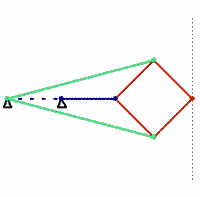Peaucellier-Lipkin linkages: Difference between revisions
From
No edit summary |
No edit summary |
||
| Line 1: | Line 1: | ||
{{Techniques infobox | {{Techniques infobox | ||
|image | |image = Peaucellier linkage animation.gif | ||
|designer | |designer = | ||
|date | |date = | ||
|vitamins = | |vitamins = | ||
|materials = | |materials = | ||
|transformations = | |transformations = | ||
|lifecycles = | |lifecycles = | ||
|parts | |parts = [[Frames]], [[Bolts]], [[Nuts]], [[End caps]] | ||
|techniques | |techniques = [[Bolting]], [[Live hinges]] | ||
|tools | |tools = [[Wrenches]] | ||
|git | |git = | ||
|stl | |stl = | ||
}} | }} | ||
Revision as of 11:13, 26 May 2021
Technique: Peaucellier-Lipkin linkages
| Tools: | Wrenches |
|---|---|
| Parts: | Frames, Bolts, Nuts, End caps |
| Techniques: | Bolting, Live hinges |
Introduction
The Peaucellier–Lipkin linkage (or Peaucellier–Lipkin cell, or Peaucellier–Lipkin inversor), invented in 1864, was the first true planar straight line mechanism – the first planar linkage capable of transforming rotary motion into perfect straight-line motion, and vice versa.
